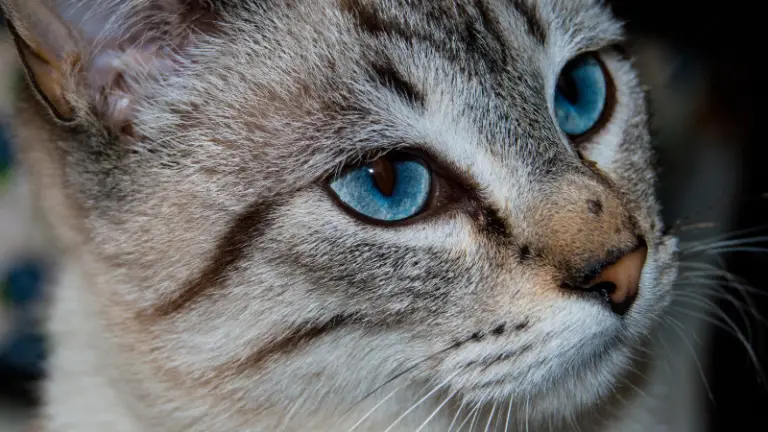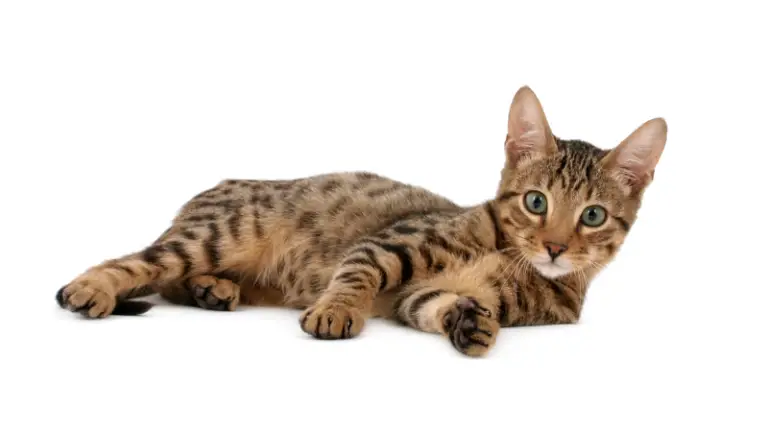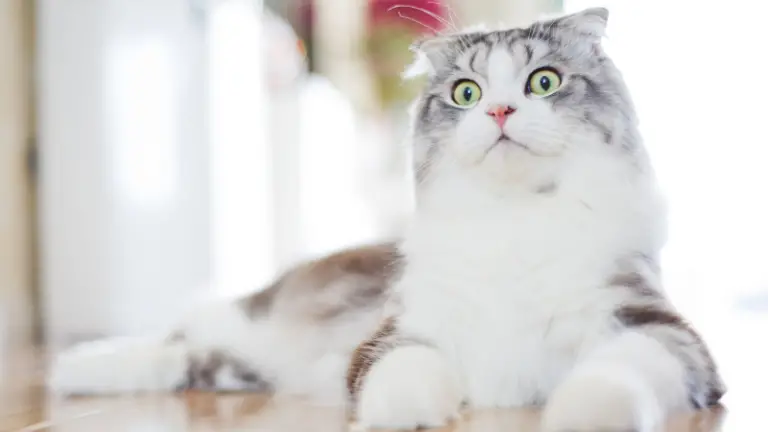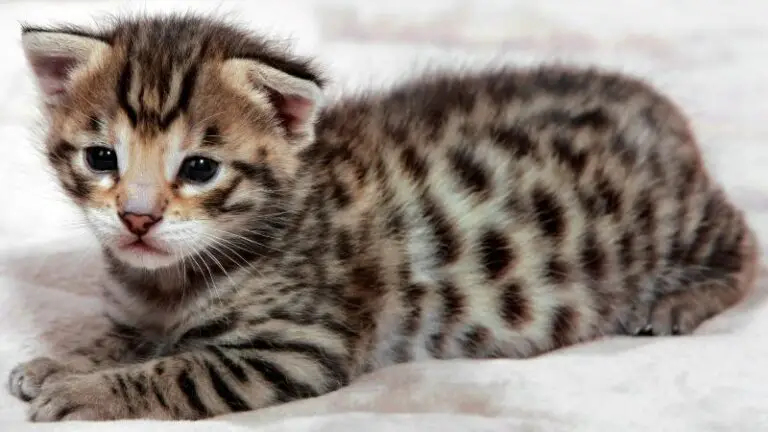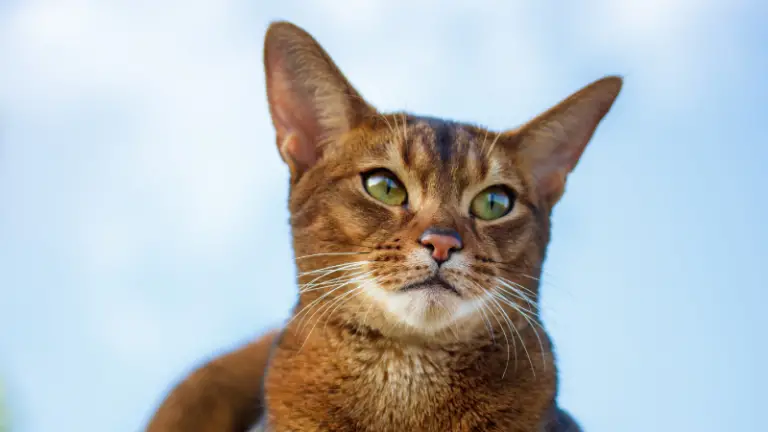WHAT CATS LIKE WATER? 21+ CATS THAT MIGHT LOVE SWIMMING
What cats like water? Cats are famous for hating water, it is difficult to bathe them, and they run far away from a running shower. As a result, some cats are ever afraid of rain. But are all cats like that?
There are specific cat breeds that are more prone to swimming and like to get into the water; those are the Bengal, Main Coon, Turkish Van, Turkish Angora, Norwegian Forest, Manx, and others.
Let’s see what the top cat breeds that love water are.
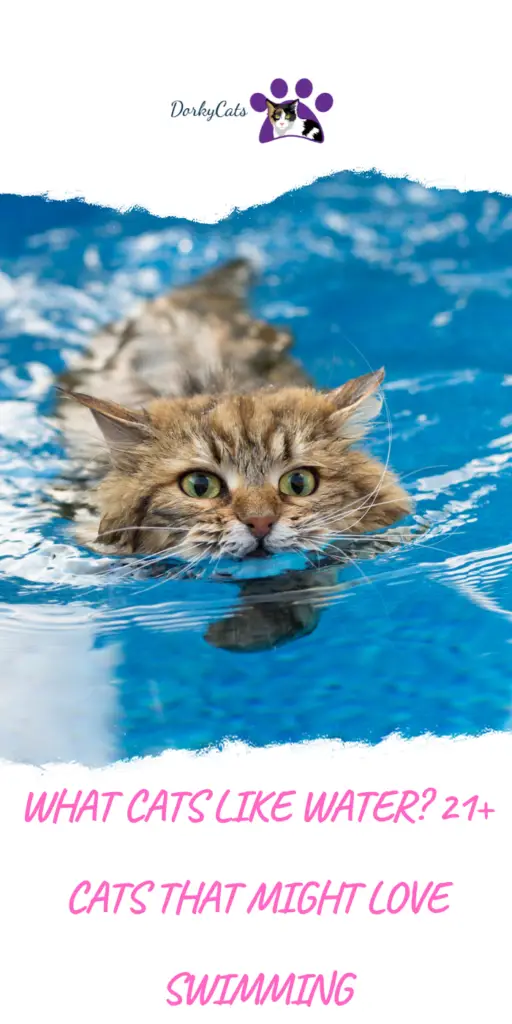
WHAT CATS LIKE WATER?
Do you have a feline friend who loves to splash around in the water? Or does your cat avoid the water as they’ve never seen it before? Cats come in all shapes and sizes, and they each have a unique personality and quirks.
For example, some cats like to be up high, while others prefer to hide underneath the sofa. Another way cats can be different is their love of water. If you’ve ever scrolled past an internet video of a cat playing with the water coming out of the sink faucet, you might be wondering which breeds of cat-like water.
In addition, some cats like watching the water running from the tap, but still, they do not like getting wet or in it.
Here are the top cat breeds that like water:
1. THE TURKISH VAN

The Turkish Van cat is known to love the water so much that it has earned the nickname “the swimming cat.” Like many cats that enjoy the occasional dip, they have a longer coat that helps to keep them slightly waterproof when they get wet!
The Turkish Van cat originated in Turkey near Lake Van. The first sightings date back to 1400 AD, and are said to have arrived in Europe as a gift from the sultans.
According to the legend, Allah gave this cat its typical spots on the fur. Then, one day Allah was walking on Lake Van’s shores and noticed a white cat in the water.
Thinking that he was about to drown, he saved him by taking him by the tail and the head, right where the typical red spots on the fur appeared. But after selling that other white cats were also diving into the lake, Allah realized that the cat he had saved was not really in trouble.
The Turkish Van gets his swimming ability from his history of living near the lake and enjoying the water to cool down.
2. THE TURKISH ANGORA

Another feline that hails from Turkey, where there are a lot of lakes and bodies of water, the Angora, has a thick coat that helps to keep it warm. They are known to love both swimming and splashing around in sinks!
In Turkey, this cat is considered a national heritage. In fact, Mohammed promised him a place in paradise. But even the Europeans have not been able to resist the charm of this cat which is characterized by a unique elegance and silky hair.
Their fluffy coat requires a good combing once a week and twice during the shedding period. A bath every now and then will do him good, but you have to get used to him as a child to remind him that he can get along with water.
3. THE NORWEGIAN FOREST CAT

These beautiful cats have a super thick coat that was probably intended to keep them warm and dry in the cold winters of their native land. But, because they are hunters by nature, they are not afraid to take a swim in a body of water in search of lunch!
Since the dawn of time, the Norwegian Forest cat has appeared among a thousand legends that populate the folklore of the ancient populations of northern Europe, but the first writings that attest to the existence of this breed date back to 1559 and are the work of the priest and naturalist Peter Clausson Frii.
The scholar then residing in Norway was the first to categorize Norwegian lynxes into three classes:
- The lynx-wolf
- The lynx-fox
- The lynx-cat
The Norwegian Forest Cat descends from these first lynx specimens that came from the south of Europe and Africa and, through natural selection, modified their coat to survive the harsh climates of the Scandinavian peninsula.
The affinity for water and the ability to swim come from these ancestors of the Norwegian Forest.
4. THE MAINE COON

These regal felines are the largest domestic cat breed and have long, thick coats and oversized paws. They even come complete with tufts of insulating fur between their toe pads and in their ears.
It’s not uncommon to spot Maine Coons using their paw to scoop water out of their bowl instead of drinking it with their tongue!
For some, this cat is descended from lynxes. For others, it is a cross with raccoons, and for others, it seems to be a distant relative of the Norwegian Forest cat. But all of those relations could justify the affinity with water.
The Main Coon is one of the oldest cat breeds in North America. Its name derives from the state of Maine, from which it is thought it originated, and from the term “coon” which means “raccoon.”
The origins of this breed are still shrouded in mystery, which makes this cat breed even more fascinating. However, despite the presumed wild origins, the Main Coon is an amiable cat, very playful, and loves to be surrounded by friends, dogs, and humans.
It is an inquisitive cat for the duration of his life. However, he is docile with children and patient. He likes to be an active part of home life. It is also a brilliant cat who is easy to train and likes to travel.
5. THE BENGAL

Bengal cats are known for being very closely related to their wild cousins, the Asian leopard. To keep one as a pet, Bengals need to be at least four generations removed from actual leopards.
But even this doesn’t stop these cats from exhibiting some wild behavior, including splashing and swimming in water. The Asian leopard cat is a wild species of cat prevalent mainly in Southeast Asia and the Indian subcontinent.
The leopard cat is mainly a solitary, reckless climber and a skilled swimmer who hunts at night. The Bengal cat takes his swimming ability from those traits of the leopard cat.
Since Bengal cats like water, remember to close the bathroom door before showering if you do not want to have an unexpected guest with you in the shower.
6. THE AMERICAN BOBTAIL

While many cats on this list seem to get their affinity for water from their genetics, Bobtails probably love it so much due to their playful and intelligent nature. These cats love to play and will find ways to entertain themselves, including turning on the faucet!
This cat with a funny squat and rounded tail is very rare outside the country of origin, the United States. However, this breed may have originated from a mix between a domestic cat and a bobcat.
It is a very affectionate cat, but unlike other cat breeds, it binds to all family members, not just one in particular. Despite the friendly character, this cat usually proves somewhat wary of strangers. But they like to be integral to family life and require constant attention from their masters.
Even if he can live in an apartment, he must not miss a garden or open spaces where he can vent his desire to play. It is a lively but not hyperactive breed like the Abyssinian, for example.
7. THE JAPANESE BOBTAIL

In Japan, the tricolor Bobtail variety, which is also the most widespread, is called “Mi-ke,” which means “lucky”; this cat is considered an authentic lucky charm.
Contrary to this cat’s name, this breed originates in exotic Chinese lands. Some documents dating back to 1000 BC speak of the presence in China of cats endowed with a particular mutation to the tail to give it an almost deformed appearance.
These particular cats were imported to Japan around the 11th century, where they are considered talismans.
It certainly cannot be said that the Japanese Bobtail is an introverted cat. On the contrary, he loves the company of people in the house and strangers. Therefore, sharing affection with his owners and other animals such as dogs and cats is no problem.
His movements are harmonious like those of a graceful dancer, and it is practically impossible not to be seduced by his elegant bearing.
A lover of children, the Japanese Bobtail is a lively cat that adapts well to apartment life, provided that you dedicate yourself to long play sessions with him on your return. As a good climber, he loves to snuggle up on his master’s shoulders.
8. THE MANX

These cats are well known for their short tails, but their love of water and taking the occasional dip puts them on this list. Interestingly, the Manx originated on the Isle of Man, which may have led to their affinity for water.
Manx originates from the Isle of Man, in the Irish Sea, from which it takes its name. In addition to the peculiarity of the lack of tail, it has another singular characteristic. The rear legs are longer than the front legs, which gives it a hopping gait and is different from that of other cats but more similar to that of rabbits or hares.
Intelligent and lively, this cat is similar to a dog, as shown by the attachment to its owners, the habit of burying one’s toys, and the habit of bringing back the thrown stick.
The Manx is affectionate and cheerful with the whole family and loves to play even as an adult. He is not shy with strangers but can be hostile to those he doesn’t like.
8. THE EGYPTIAN MAU

This breed makes the frequent swimmer list because of its love for the hunt. These ancient cats have a unique spotted coat, are incredibly playful, and are not afraid to chase prey through a body of water by taking a little plunge!
One of the ancient Egyptian legends, which is still in vogue in Middle Eastern countries, wants these cats to bring luck because they have been the cats of the pharaohs for centuries.
Adopting an Egyptian Mau would be a good omen, especially for the host family. Some like to call it a small “parlor leopard.” The Egyptian Mau is a remarkably agile, active cat and speedy runner (it can reach up to 55 k / h without effort).
Despite its predatory qualities, this cat is not aggressive in the family but friendly, affectionate, and playful.
9. THE ABYSSINIAN

Agile and lithe, it stands out for its feline elegance and lively character. He would never stray from his master and knows how to entertain with sensational acrobatic performances.
Certainly among the most ancient feline breeds, the origin of the Abyssinian is still quite controversial. The name does not indicate the true native country but rather the one from which the first specimen arrived in Europe at the end of the Abyssinian war in 1868.
Hyperactive, intelligent, and extremely curious, the Abyssinian conquers above all for the sweet character and the particularly musical meow. He loves the company of young and old, dogs and other cats. In short, he is a friendly cat, even if a little self-centered at times.
It is perfect for apartment life, but the excessive liveliness leads him to combine a few too many troubles. Typically, he only bonds with one person at a time and loves walking outside the home.
10. THE SIBERIAN

The robust appearance of the Siberian suggests that it is a natural breed originating from the cold Russian and Ukrainian regions.
In truth, there is no specific information about the origins of the Siberian yet. Still, it seems that it descends from a cross between wild cats from the Ural mountains and the first examples of domestic cats imported by settlers.
The Siberian is mainly known for its quiet, sweet, and affectionate character, although its wild origins must never be mastered.
Even if he lives well in the apartment, this cat must also be able to have open spaces to give free rein to his hunting instinct and his desire to play, and above all, for the feline passion for climbing.
Although he coexists well with cats and dogs, a fish or bird should not be placed next to him due to his hunting instincts.
11. THE SNOWSHOE

The Snowshoe is a little-known and widespread cat that blends the characteristics of the breeds from which it derives: the length of the Siamese and the strength of the American Shorthair.
The name of this breed refers to the characteristic white-gloved feet. The Snowshoe has undoubtedly inherited the affectionate and friendly character from its Siamese cousin, even if it must be said that they are decidedly less intrusive.
He loves to participate in family life and does not like loneliness. Compared to the Siamese, he is certainly less overbearing, but he does not tolerate being disturbed in activities considered by him as sacred as a nap and a meal.
He appreciates physical contact and has a reverence for running water.
12. THE SIAMESE

The Siamese cat is native to Thailand, particularly from the region known as the Kingdom of Siam until 1939. These cats are known to have belonged to famous people such as Queen Elizabeth II of England and James Dean.
The Siamese cat stands out for its dedication and sensitivity to its owner. It is a very affectionate cat to the point of being very possessive towards the person he chooses as a life partner.
The Siamese is an outgoing and very communicative cat. He is also active with an exuberant temperament. Behind those elegant and somewhat haughty ways hides an eternally playful nature. But he’s brilliant and doesn’t like being bossed around.
13. BURMESE

The Burmese come from an ancient lineage of cats dear to Buddhist monks. This cat knows how to combine the liveliness and sweetness of character with regal exotic beauty.
It seems that the Burmese derive from an ancient oriental race called Sulapak, which is mentioned in some documents of the eighteenth century. The Burmese is an extremely sweet and adorable cat with a constant need for attention.
This cat tends to become very fond of the owner, even following him like a dog. It proves sociable and well predisposed to coexistence with other cats and dogs.
He likes to live in an apartment but better if there is a terrace with many plants.
14. AMERICAN SHORTHAIR

The breed’s name was changed in 1965 to emphasize its origins. Unfortunately, the American Shorthair did not have much luck overseas. Nonetheless, the United States has a large following among the people.
This cat resembled a slightly grown domestic cat and was initially called the Domestic Shorthair. It is a balanced and pleasant cat able to adapt to new situations.
He gets along well with cats, dogs, and people, but loves being outdoors and exploring.
15. BRITISH SHORTHAIR

The thick coat and hunting prowess suggest he is a free spirit, but in reality, a British Shorthair appreciates domestic warmth more than anything else.
Related to the European cat, the British Shorthair is not born from the Anglo-Saxon lands but descends from the ancient African cat imported to Rome by the legionaries and later disembarked on the coasts of Scotland by the Roman conquerors.
Perfectly adaptable to country life, these cats undoubtedly prefer the comforts of an apartment. However, as kittens, they are very active; as adults, they are real “couch potatoes,” dedicated to long naps in armchairs or near a radiator.
Their lazy nature makes them a discreet presence in the family, but appearances must not deceive us. In fact, behind those sleepy eyes, there is a fine observer.
He has a friendly character that is well suited to life with children and other animals.
16. THE SAVANNAH

Savannahs are gorgeous cats with a very distinctive coat design. It tends to chirp and hiss when it purrs. This breed’s species are considered the largest domestic cats in the world.
They descended from the African Serval and were created in 1986 by Judee Frank, a Bengal breeder who managed to mate a serval and a Siamese cat.
It is a rather massive hybrid wildcat with a dog-like character so much that to greet people, and it can jump towards them just like dogs do.
He is an active and outgoing cat; you can take him out on a leash and go swimming.
17. THE SPHYNX

It is a very unusual and curious-looking breed, but unlike what seems, the Sphynx is not completely hairless. The hair is actually very short, extremely sparse, and to the touch, it is velvety, more or less like the skin of a peach.
It does not disdain water even if too much bath can hurt it as it can alter the skin’s PH, giving rise to various ailments.
The Sphynx was born from a natural mutation of the typical domestic cat; in Canada in the 70s, a stray cat gave birth to hairless kittens.
They have a strong and determined character, do not know the concept of submission, always wants to be the center of attention, and have a playful personality.
Affectionate to the point of being clingy, he fears loneliness and loves the company of other cats or dogs.
18. THE BOMBAY

Sinuous and enigmatic like a panther, the Bombay cat owes its name to the love of its breeder for the writer Kipling.
A Kentucky breeder Nikki Horner, attracted by the wild spirit of the panther described in Rudyard Kipling’s “The Jungle Book,” wanted to give birth to a cat breed that exhibited the same charm of the panther associated with a sweet character by crossing a Burmese with an American shorthair cat.
The Bombay inherited the Burmese’s sweet temper and the American cat’s lively temperament. As a result, this cat is predisposed to learning and responds when called by name.
He has a deep relationship with his boss and also bonds with children even if he can become despotic if he doesn’t like something.
19. THE SINGAPURA

Like a small lynx, the Singapura can be an extraordinary life partner for young and old. This cat is the result of a natural selection of cats on the island of Singapore.
In general, it is a pretty quiet cat, making it perfect as a pet. In the presence of strangers, he can become shy and distrustful, but he does not indulge in aggressive attitudes.
He is a great admirer of apartment life, even if he likes to go out in the open air. He has no problem living with other animals and humans and usually bonds with one person profoundly.
20. BURMILLA

The Burmilla was born from the crossing between a Burmese and a Chinchilla Persian and immediately won a place of honor in the hearts of cat lovers worldwide.
More precisely, this magnificent cat is descended from a cross between a Persian chinchilla cat and a lilac Burmese. This combination created a beautiful-looking cat but with an even more intriguing personality.
The Burmilla reflects the intelligence and vivacity of the Burmese and the regal calmness of the Persians. Nevertheless, the generally quiet disposition hides a strong character.
The Burmilla is a decidedly pleasant cat that becomes attached to all family members. He always wants to be the center of attention, and if someone forgets his presence, he is immediately reprimanded with loud meows.
21. THE SOMALI

The Somali cat is a semi-long-haired version of the Abyssinian cat and is distinguished by its cousin for the more intense color of the hair and the wilder shades.
This cat was not born in Somalia, as the name suggests, but in the United States between the 19th and 20th centuries with a cross between an Abyssinian cat and other long-haired cats.
The character is similar to that of Abyssinian cats; it is a friendly cat and loves being in the company of humans and other cats or dogs. He is also brilliant and curious.
The Somalian is extremely lively; he likes to jump, play, and climb the most inaccessible peaks, so a garden or terrace would be perfect.
He is capable of great emotional outbursts, but he is also a stubborn cat.
DOES ANY CAT LIKE WATER?
There is a difference between cats that like to get into water or want to play with water.
In general, most cats do not like to get into the water, although there are many exceptions like the breeds mentioned above ( Abyssinian, Main Coon, Savannah, and others). However, especially the cats that have ties with big cats and descend from them still have the instinct to swim.
However, the typical domestic cat doesn’t like to get into the water; it is difficult to find a cat that loves to get a bath or that jump into the water of his own will. In addition, some cats have water-resistant coats, so they might seem to enjoy the water more than other cats.
However, many cats are curious about running water, and it is common to spot a domestic cat attempting to paw at the running water or otherwise be fascinated with it.
WHAT BIG CATS LIKE WATER THE MOST?
In general, the big cats that love water the most are tigers, panthers, leopards, and jaguars. It is easy to guess that most big cats are excellent swimmers and enjoy getting into the water to cool off if necessary.
Other big cats are familiar with water and would get into it to hunt or while running away, not because they want to get wet. But, since they live in the wild, they must be familiar with swimming and getting wet.
In addition, some of the big cats live in places with high temperatures, and jumping into water is really refreshing.
WHY DON’T CATS LIKE WATER?
There are different theories as to why cats do not like water. The main ones are:
- They do not like what water does to their fur
- They are not used to or familiar with it
- It takes too long to dry off
- They descend from cats that used to live in the desert (habit to little water)
- They are not used to getting in the water when they are kittens
In general, cat descends from ancestors that used to live in the desert, so by instinct, cats are not accustomed to dealing with a lot of water. In addition, many cats do not like to get wet because their fur retains it for too long and is hard to dry.
There are always exceptions for cats that love water or swimming. Maybe they descend from big cats, or their fur is better suited to resist water, or they were used to swimming at a very young age.
FREQUENTLY ASKED QUESTIONS
Why does my cat like water?
If your cat likes water, it means that he got used to it when he was a kitten, or that he is from a particular breed that descended from big cats, or cats that used to live near a lot of water. On the other hand, maybe your cat is curious and likes playing with water.
How to tell if your cat likes water?
If your cat likes water, you will know that he will try to get into the bathtub, shower, or sink while the water is running. If your cat runs away as soon as you get the water running, you know he is afraid of it.
Do siamese cats like water?
In general, Siamese cats might like water more than other cat breeds. This is because they are originally from Thailand and are known to play and be tolerant of water.
Do tabby cats like water?
Tabby cats might like water if they belong to a breed that enjoys being around water. Of course, the breed is a factor, but the upbringing and training can make a tabby cat like water.
Do Siberian cats like water?
Siberian cats come from cold places and are known to like water more than many other cat breeds. Of course, there are always exceptions, but in general, Siberian cats are more likely to enjoy the water.
What kind of water do cats like?
Cats like to drink clean water without strange taste or smell. In general, filtered water, or the water that humans drink, is excellent for cats, for example, bottled water from the store. It should not be too cold or too hot.
What temperature water do cats like to drink?
Cats should drink slightly cold water, not too cold and not too warm. If it is summer, fresh and chill water is enjoyable for cats, while room temperature water is fine in winter.
What percentage of cats like water?
There aren’t official studies, but by observations, a minority of cats would jump into the water. So maybe out of 10 cats, 2-3 can be found to be comfortable with water, which makes 20-30 %, and this is an optimistic look at the situation.
CONCLUSION
This is by no means a definitive list of feline breeds which might be drawn to the water. Many other species enjoy the occasional swim or just love to splash around with their paws in your bathroom sink.
Remember that cats have very individual personalities, so their inclusion on this list doesn’t guarantee they will have a love for the wet stuff. But this article should be a good starting point if you’re looking for the answer to what cats like water.


